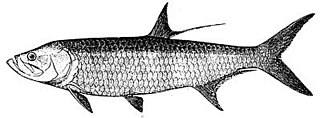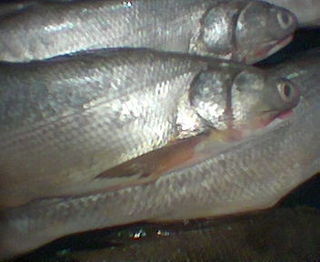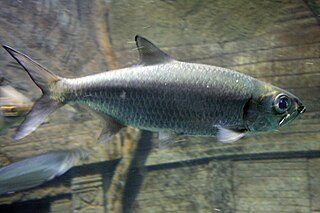
Cod is the common name for the demersal fish genus Gadus, belonging to the family Gadidae. Cod is also used as part of the common name for a number of other fish species, and one species that belongs to genus Gadus is commonly not called cod.

Mackerel is a common name applied to a number of different species of pelagic fish, mostly from the family Scombridae. They are found in both temperate and tropical seas, mostly living along the coast or offshore in the oceanic environment.

Herring are forage fish, mostly belonging to the family of Clupeidae.

The Elopiformes are the order of ray-finned fish including the tarpons, tenpounders, and ladyfish, as well as a number of extinct types. They have a long fossil record, easily distinguished from other fishes by the presence of an additional set of bones in the throat.

Sprat is the common name applied to a group of forage fish belonging to the genus Sprattus in the family Clupeidae. The term also is applied to a number of other small sprat-like forage fish. Like most forage fishes, sprats are highly active, small, oily fish. They travel in large schools with other fish and swim continuously throughout the day.

The Elopidae are a family of ray-finned fish containing a single living genus Elops. They are commonly known as ladyfish, skipjacks, jack-rashes, or tenpounders.

The ladyfish or tenpounder is a species of fish in the genus Elops, the only genus in the monotypic family Elopidae.

The European river lamprey, also known as the river lamprey or lampern, is a species of freshwater lamprey.

The Pacific ladyfish, also known as the Pacific tenpounder and machete, is a species of ray-finned fish in the genus Elops, the only genus in the monotypic family Elopidae. The Pacific ladyfish can be found throughout the southwest U.S. and other areas in the Pacific Ocean.

The West African ladyfish is a species of ray-finned fish in the family Elopidae. It is native to the coastal waters of the eastern Atlantic Ocean, from Senegal to Angola. It is also known as the Guinean ladyfish. Some have been known to grow to 20 lb (9.1 kg).
The Senegalese ladyfish is a species of ray-finned fish in the family Elopidae, and is native to the coastal waters of the eastern Atlantic Ocean from Mauritania to the Democratic Republic of the Congo. It is often confused with the West African ladyfish, Elops lacerta, and can be distinguished only by the number of gill rakers on the lower part of the first gill arc, and the number of scales on the lateral line.

Elops machnata, the tenpounder, is a species of ray-finned fish in the family Elopidae in the order Elopiformes. This species is found in coastal regions of the Indian Ocean.

The Indo-Pacific tarpon, also known as the oxeye herring or simply herring due to its superficial resemblance to the true herrings, of which it is not a member, is the smaller of the two species of tarpon and lives in Indo-Pacific waters.

An anchovy is a small, common forage fish of the family Engraulidae. Most species are found in marine waters, but several will enter brackish water, and some in South America are restricted to fresh water.

Fish are very diverse animals and can be categorised in many ways. Although most fish species have probably been discovered and described, about 250 new ones are still discovered every year. According to FishBase about 34,800 species of fish had been described as of February 2022, which is more than the combined total of all other vertebrate species: mammals, amphibians, reptiles and birds.

Several species of fish are claimed to produce hallucinogenic effects when consumed, a condition known as ichthyoallyeinotoxism. For example, Sarpa salpa, a species of sea bream referred to as the "dream-fish", is commonly claimed to be hallucinogenic. These widely distributed coastal fish are normally found in the Mediterranean and around the Iberian Peninsula, west to the Azores and along the west and south coasts of Africa. Occasionally they are found in British or more northerly waters. They may induce hallucinogenic effects similar to LSD if eaten. However, based on the reports of exposure they are more likely to resemble hallucinogenic effects of deliriants than the effects of serotonergic psychedelics such as LSD. In 2006, two men who apparently ate the fish experienced hallucinations lasting for several days. The likelihood of hallucinations depends on the season. Sarpa salpa is known as "the fish that makes dreams" in Arabic.
The malacho or Southern ladyfish, is a species of ray-finned fish in the genus Elops, the only genus in the monotypic family Elopidae.
Albula argentea, the silver sharpjaw bonefish, is a species of marine fish found in the tropical western Pacific Ocean. They grow up to 70 cm (28 in).














